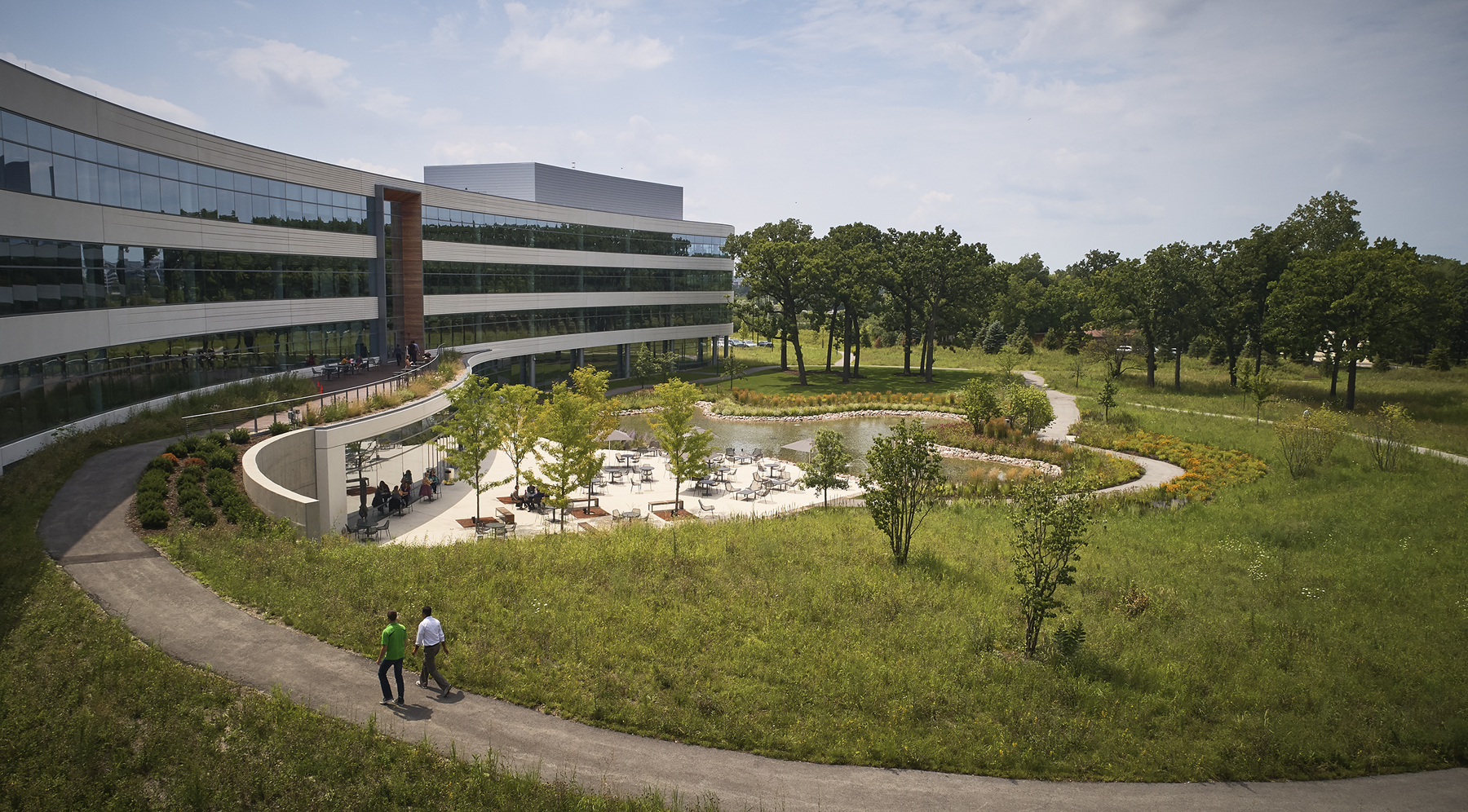The Great Outdoors: Driving Organizational Success Through Meaningful Office Design
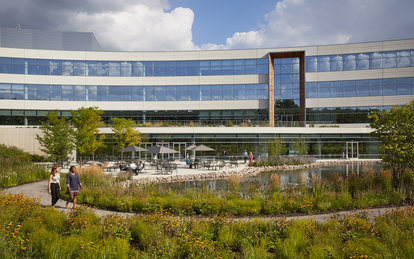
How to create meaningful outdoor spaces that will have long lasting impacts on both the organization and the community.
This article, authored by Deborah Nemeth, Jen Vogel & Kris Lucius of SmithGroup, was previously published in Work Design Magazine.
As designers and architects, it is important to understand each client and their unique project and business drivers. Organizations are focusing on a new set of metrics for measuring success– metrics that focus on their people; shifting away from traditional measures of return on investment such as cost per square foot or first cost and turning to new measures that focus on wellness, retention, engagement and productivity. Employees comprise 80 to 90% of a company’s operating expenses which builds a strong case to create space that first and foremost supports an organization’s most valuable asset – it’s people. These new measurements of success that have helped to define key business drivers for organizations, often suggest a better connection to the outdoors in order to promote wellness and wellbeing, increase productivity and attract and retain top talent.
SmithGroup recently designed a new corporate headquarters for The Chamberlain Group, one of the world’s largest manufacturers of residential and commercial door operators and products, in Oak Brook, Illinois. Capitilizing on SmithGroup’s integrated service approach, the design team included workplace strategists, architects, interior designers, site planners and landscape architects. A key mission for the new 20-acre campus was to attract young tech talent by offering an amenity unavailable in downtown Chicago – the opportunity to work in a robust and restorative parkland directly integrated with one’s workplace. Therefore, the integrated team created a site design that rethinks the suburban corporate campus as a habitat for collaboration, employee wellness and ecological health.
Focusing on employee wellness, the landscape and site design of the new headquarters brings outdoor experiences into close physical and visual proximity and ties them programmatically to the interior work environment. These spaces include a shaded lakeside dining terrace, wildflower gardens, and a looped trail network that connects to the building at multiple points and levels. The trails link employees with outside amenities designed for a full spectrum of uses, active to passive, and gathering spaces sized for a range of employee, family, and corporate gatherings.
The layout of the site and amenity spaces center around user experience and focus on how people can encounter the landscape at different points throughout the workday. These experiences are wide-ranging and shared by employees at all levels. They vary from the drive into the campus, finding space for team meetings, having a quiet one-on-one conversation, alone time walking or running, or simply looking out a window. These experiences are coordinated with best practices for ecological restoration and stormwater management, creating a rich environment that fuses mental and environmental wellness and sustainability.
The most directly accessible and largest outdoor space is the lakeside dining terrace, an extension of the building’s cafe and dining room. The space offers movable furnishings to take advantage of warm sunny days or the dappled shade from the grove of honey locusts that partially cover it. An adjacent lake is a calming presence that cools the terrace and grounds the building, terrace, and surrounding landscapes.
Turf lawns play a role in this contemporary office park as strategic recreation areas, not default groundcover. They are located near building entries and paths for convenience for team gatherings or breaks, and their placement adjacent to gardens and natural areas help to enhance and contrast those spaces.
The mature bur oaks were preserved and rescued from the Buckthorn that had crowded out the understory, now reestablished with native grasses and wildflowers. The multi-use trails extend through the restored woodlands and savanna, making ecology an experiential amenity for employees who take breaks and meetings amidst the abundant butterflies, crickets, and songbirds that inhabit the grasslands.
There is no question the intentional design and implementation of the outdoor spaces, site and landscape design has had positive impacts on the organization both from an operational performance and cultural standpoint. There has been a marked increase in recruitment and retention for the organization exceeding their near-term growth expectations by 40%. The outdoor trails and amenity areas are frequently used, and not just for leisurely walks. The community has benefited from the outdoors space at the corporate campus as well. Employee groups have emerged to organize a series of 5K runs which have included over 200 employees and raised thousands of dollars for both local and national charities.
Lake Trust Credit Union Headquarters in Brighton, Michigan is another great example of mixing functionality and connection to the outdoors. SmithGroup’s integrated team including workplace strategists, architects, interior designers, landscape architects, site planners, and MEP, structural and civil engineers worked side-by-side to create the optimal design solution. The building was sited to ensure 90% of the significant trees remained both for their natural beauty as well as to act as a visual screen and buffer the sound from nearby roads. The office design mimics the 17 acres of natural surrounding with a large living wall that serves as the backdrop to the front entry porch, creating an inviting place to sit, work, or meet. Also, tree-like columns frame the entry overhang creating a welcoming approach, mimicking the original forest from years ago. The back patio, used by employees as a respite away from the workday, looks out on a pond with idyllic green surroundings.
There is no question the intentional design and implementation of the outdoor spaces, site and landscape design has had positive impacts on the organization both from an operational performance and cultural standpoint.
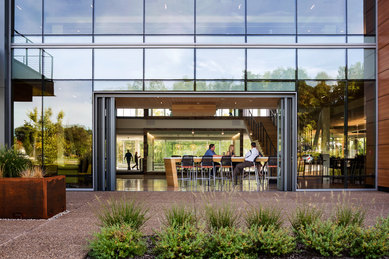
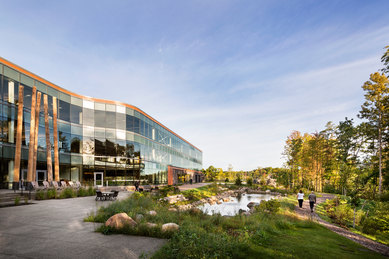
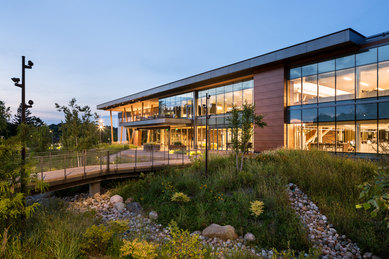
New landscaping was designed to require 50-percent less irrigation, reducing the use of potable water by 33-percent. Storm water runoff is routed through infiltration basins that are designed to infiltrate storm water into the ground water, a practice believed to be highly efficient in removing pollutants and recharging the ground water, thus restoring flows to the surrounding stream systems. The overflow is then collected and stored in a bio-retention area. This solution creates a natural, comforting tie to the surrounding foliage, while acting as a cost-effective solution.
Employees report that the expansive glass providing views out of the open office into the woods, as well as the provision of outdoor workspace via balconies and terraces, improve their overall work experience and creative problem-solving ability. This extension of the workplace experience including operable walls to open up the office space to the outside truly blurs the boundary between the interior and exterior spaces. With almost 90-percent of respondents reporting that they believe the new office has had a positive effect on their health and wellbeing.
For each of these respective companies, creating employee amenities that tie to the great outdoors support the organization’s people by boosting recruitment and retention and supporting health and wellbeing; demonstrating the importance of focusing on both interior and exterior spaces when creating design solutions. Design, project and organizational goals were fulfilled through an integrated design approach, creating meaningful outdoor space that will have long lasting impacts on both the organization and the community.
